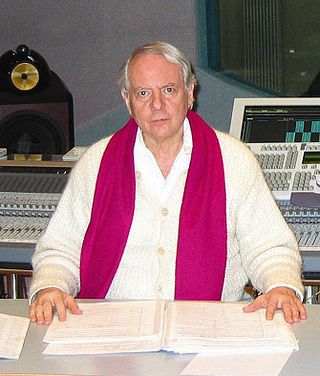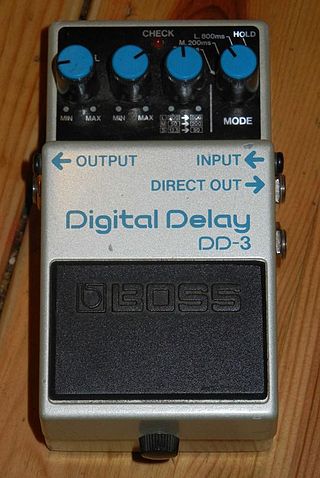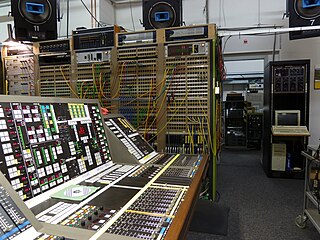Related Research Articles
Electronic music broadly is a group of music genres that employ electronic musical instruments, circuitry-based music technology and software, or general-purpose electronics in its creation. It includes both music made using electronic and electromechanical means. Pure electronic instruments depended entirely on circuitry-based sound generation, for instance using devices such as an electronic oscillator, theremin, or synthesizer. Electromechanical instruments can have mechanical parts such as strings, hammers, and electric elements including magnetic pickups, power amplifiers and loudspeakers. Such electromechanical devices include the telharmonium, Hammond organ, electric piano and electric guitar.

Quadraphonic sound – equivalent to what is now called 4.0 surround sound – uses four audio channels in which speakers are positioned at the four corners of a listening space. The system allows for the reproduction of sound signals that are independent of one another.

Surround sound is a technique for enriching the fidelity and depth of sound reproduction by using multiple audio channels from speakers that surround the listener. Its first application was in movie theaters. Prior to surround sound, theater sound systems commonly had three screen channels of sound that played from three loudspeakers located in front of the audience. Surround sound adds one or more channels from loudspeakers to the side or behind the listener that are able to create the sensation of sound coming from any horizontal direction around the listener.

In music, tape loops are loops of magnetic tape used to create repetitive, rhythmic musical patterns or dense layers of sound when played on a tape recorder. Originating in the 1940s with the work of Pierre Schaeffer, they were used among contemporary composers of 1950s and 1960s, such as Éliane Radigue, Steve Reich, Terry Riley, and Karlheinz Stockhausen, who used them to create phase patterns, rhythms, textures, and timbres. Popular music authors of 1960s and 1970s, particularly in psychedelic, progressive and ambient genres, used tape loops to accompany their music with innovative sound effects. In the 1980s, analog audio and tape loops with it gave way to digital audio and application of computers to generate and process sound.
Electroacoustic music is a genre of popular and Western art music in which composers use technology to manipulate the timbres of acoustic sounds, sometimes by using audio signal processing, such as reverb or harmonizing, on acoustical instruments. It originated around the middle of the 20th century, following the incorporation of electric sound production into compositional practice. The initial developments in electroacoustic music composition to fixed media during the 20th century are associated with the activities of the Groupe de recherches musicales at the ORTF in Paris, the home of musique concrète, the Studio for Electronic Music in Cologne, where the focus was on the composition of elektronische Musik, and the Columbia-Princeton Electronic Music Center in New York City, where tape music, electronic music, and computer music were all explored. Practical electronic music instruments began to appear in the early 20th century.

Licht (Light), subtitled "Die sieben Tage der Woche", is a cycle of seven operas composed by Karlheinz Stockhausen between 1977 and 2003. The composer described the work as an "eternal spiral" because "there is neither end nor beginning to the week." Licht consists of 29 hours of music.

Delay is an audio signal processing technique that records an input signal to a storage medium and then plays it back after a period of time. When the delayed playback is mixed with the live audio, it creates an echo-like effect, whereby the original audio is heard followed by the delayed audio. The delayed signal may be played back multiple times, or fed back into the recording, to create the sound of a repeating, decaying echo.
Robin John Maconie is a New Zealand composer, pianist, and writer.

Hymnen is an electronic and concrete work, with optional live performers, by Karlheinz Stockhausen, composed in 1966–67, and elaborated in 1969. In the composer's catalog of works, it is No. 22.

Telemusik is an electronic composition by Karlheinz Stockhausen, and is number 20 in his catalog of works.
Live electronic music is a form of music that can include traditional electronic sound-generating devices, modified electric musical instruments, hacked sound generating technologies, and computers. Initially the practice developed in reaction to sound-based composition for fixed media such as musique concrète, electronic music and early computer music. Musical improvisation often plays a large role in the performance of this music. The timbres of various sounds may be transformed extensively using devices such as amplifiers, filters, ring modulators and other forms of circuitry. Real-time generation and manipulation of audio using live coding is now commonplace.

In sound recording and reproduction, audio mixing is the process of optimizing and combining multitrack recordings into a final mono, stereo or surround sound product. In the process of combining the separate tracks, their relative levels are adjusted and balanced and various processes such as equalization and compression are commonly applied to individual tracks, groups of tracks, and the overall mix. In stereo and surround sound mixing, the placement of the tracks within the stereo field are adjusted and balanced. Audio mixing techniques and approaches vary widely and have a significant influence on the final product.

Dienstag aus Licht is an opera by Karlheinz Stockhausen in a greeting and two acts, with a farewell, and was the fourth of seven to be completed for the opera cycle Licht: Die sieben Tage der Woche. It was begun in 1977 and completed from 1988 to 1991, to a libretto by the composer.
Spatial music is composed music that intentionally exploits sound localization. Though present in Western music from biblical times in the form of the antiphon, as a component specific to new musical techniques the concept of spatial music was introduced as early as 1928 in Germany.
Cosmic Pulses is the last electronic composition by Karlheinz Stockhausen, and it is number 93 in his catalog of works. Its duration is 32 minutes. The piece has been described as "a sonic roller coaster", "a Copernican asylum", and a "tornado watch".

Oktophonie (Octophony) is a 1991 octophonic electronic-music composition by Karlheinz Stockhausen. A component layer of act 2 of the opera Dienstag aus Licht, it may also be performed as an independent composition. It has a duration of 69 minutes.
Unsichtbare Chöre is an eight-channel electronic-music composition by Karlheinz Stockhausen. A component part of the opera Donnerstag aus Licht, it may also be performed as an independent composition, in which form it is designated "ex 49" in the composer's catalog of works.

Williams Mix (1951–1953) is a 4'16" electroacoustic composition by John Cage for eight simultaneously played independent quarter-inch magnetic tapes. The first piece of octophonic music, the piece was created by Cage with the assistance of Earle Brown, Morton Feldman, David Tudor, and Bebe and Louis Barron using many recorded sound sources on tape and a graphic score by the composer. "Presignifying the development of algorithmic composition, granular synthesis, and sound diffusion," it was the third of five pieces completed in the Project for Music for Magnetic Tape (1951–1954), funded by dedicatee architect Paul F Williams Jr. Richard Kostelanetz of Stereo Review described Williams Mix as a "tape collage composed ... by chance procedures" which, similar to Cage's earlier works, was "offered to the world in a permanent form."

Lawo is an international company based in Rastatt, Germany, specializing in the manufacture of digital mixing consoles and other professional audio equipment. It was founded in 1970 by Peter Lawo, and is currently run by his son Philipp. The company is notable for supplying the audio mixing equipment for the 2012 London Olympics and Nine Network, and for sports events in Asia, North America and Australia.
Mixed music is music combining acoustic instruments and fixed-media electronics or more generally, music which combines acoustic-instrumental and electronic sounds sources ; mixed music is therefore a subcategory of electronic music. While this term could be applied to many genres, the term mixed music generally refers to contemporary classical music repertoire and is therefore distinct from live electronic music.
References
- ↑ Collins 2010, p. 60.
- ↑ Stockhausen 1993, p. 150.
- ↑ Stockhausen 2000, p. 60.
- ↑ Stockhausen 1993, pp. 151, 163.
- ↑ Collins 2010, p. 26.
- 1 2 Leider 2004, p. 290.
- ↑ Austin 2004, p. 189.
- ↑ Austin 2004, pp. 205, 207.
Cited sources
- Austin, Larry. 2004. "John Cage's Williams Mix (1951–3): The Restoration and New Realisations of and Variations on the First Octophonic, Surround-Sound Tape Composition". In A Handbook to Twentieth-Century Musical Sketches, edited by Patricia Hall and Friedemann Sallis, 189–213. Cambridge and New York: Cambridge University Press. ISBN 978-0-521-80860-6.
- Collins, Nicholas. 2010. Introduction to Computer Music. Chichester: John Wiley. ISBN 978-0-470-71455-3.
- Leider, Colby. 2004. Digital Audio Workstation. New York: McGraw-Hill. ISBN 978-0-07-142286-4.
- Stockhausen, Karlheinz. 1993. "Octophony: Electronic Music from Tuesday from Light", translated by Jerome Kohl. Perspectives of New Music 31, no. 2 (Summer): 150–70.
- Stockhausen, Karlheinz. 2000. "Neue Raum-Musik: OKTOPHONIE". In Komposition und Musikwissenschaft im Dialog I (1997–1998) , edited by Imke Misch and Christoph von Blumröder, 60–77. Signale aus Köln: Musik der Zeit 3. Saarbrücken: Pfau-Verlag. ISBN 3-89727-049-8.



